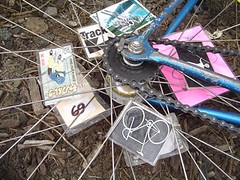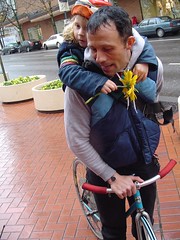Nearly every time someone complains about how bicyclists are unsafe, uncourteous, dangerous, and suicidal riders, they nearly always mention messengers. Or “those downtown messengers” as the cop put it who wrote me a ticket for rolling through a four-way stop intersection on a sleepy bike boulevard.
There’s truth to the observation that cyclists don’t know or obey the laws. But the context in which we ride is often forgotten. We ride on streets that are not designed for our safety or comfort. We are subject to laws that create dangerous grey areas when applied to cyclists. We share the road with motorists whose behavior is erratic and whose vehicle speed and weight are grossly incompatible with our own.
Messengers, who are the stereotypical fixed-gear riders, occupy an even more contested field — they work downtown, where they are often the fastest vehicles on the road, dodging motorists who are too much in a hurry to obey law, courtesy, or common sense.
Their jobs require speed and conditions require feats of quick stopping, starting, and maneuvering that most of us couldn’t execute on our best days in an empty parking lot.
They’re experts, and of course they mark and hone their skills with particular sorts of bicycles, and particular styles of riding and dressing. And of course this inspires others to the highest form of flattery, with varying results.
“The idea of unsafe “downtown messengers” is a potent myth, and we all suffer because of it.”.
Fixed-gear bikes, despite their mystique and demonization, are pretty normal and reasonable manifestations of bicycle work and culture. Messengers, with their high visibility have come to represent all bicyclists in the eyes of the city’s drivers. Many of those drivers don’t understand—or like—what they see, and are quite ready to project their misconceptions onto bicycle riders at large.
More unfortunately, many bicyclists are equally willing to play the same blame game, scapegoating messengers and other “anarchist” or “scofflaw” cyclists for this categorial prejudice.
But what does it mean to be a good cyclist or a bad cyclist? We all make mistakes, many of us are underinformed as to legal and safe riding, and frankly, the deck is stacked against us. It can be difficult to determine, in a hairy situation, what might even constitute courteous, much less safe or legal conduct on the road, or how to balance these three needs on top of the need to actually get to your destination.
Add to that the many riders who are slow, inexperienced, and may never even have driven a car. You can still see people riding the wrong way down streets like MLK and Hawthorne, cutting off cars and other cyclists, stopping too suddenly, and barrelling imprudently through dangerous intersections. And even the best of us can succumb to impatience and road rage, to the detriment of our skill and common sense.
Messengers, through experience, are less prey than the rest of us to all of these pitfalls, and are probably some of the safer road users out there. Regardless, many drivers still view them as crazy at best, threats to public safety at worst. But their job is to ride their bikes all day, and you’d better believe their first interest is in staying alive and keeping traffic moving. The idea of unsafe “downtown messengers” is a potent myth, and we all suffer because of it.
Sure, now police seem to be focused on fixed gear riders — easy targets due to their anomalous looks, behavior and downtown concentration. And messengers and their imitators are easy for the rest of us more staid-seeming cyclists to disown. But who’s next? Recently there was a ticketing blitz aimed at cyclists downtown who left the bike lane to turn left. Cyclists have been targeted for proceeding at a jogging pace through four-way stop signs on designated low-traffic residential streets.
We’re all susceptible to the same external dangers and internal dilemmas on the road. We need to recognize that we’re in this together, whether we’re lycra-clad racers, civil servants commuting in suits, DUII offenders on too-small mountain bikes, clowns on tallbikes, Zoobombers on mini bikes, hipsters cruising on comfort bikes, five year olds with training wheels, or the growing population of track-bike riders.
As bicyclists, we need to assert our right to the road, and we need to fight to make the roads work for us — all of us.



